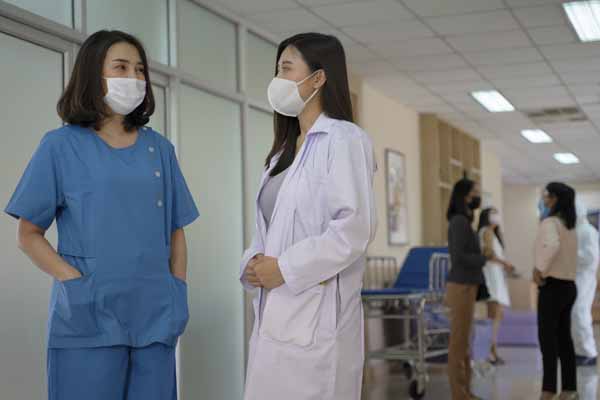
Texas Medicine Today recently reported that influenza, respiratory syncytial virus (RSV), and other respiratory ailments are poised to overwhelm hospitals and clinics. The big question then was, would this problem get worse?
The answer: Yes – it’s getting worse, says Donald Murphey, MD, a pediatric infectious disease specialist at Dell Children’s Medical Center in Austin. And while hospitals are not yet overwhelmed, the trends for flu, RSV, and COVID-19, among other respiratory viruses, all may be moving in a bad direction, threatening what some experts have dubbed a “tripledemic.”
“The RSV rates have risen and are staying high. Influenza is still rising. And I’m concerned that COVID-19 may be starting to rise, and there are other viruses as well,” said Dr. Murphey, a member of the Texas Medical Association’s COVID-19 Task Force. “If you put all that together, there’s a lot of respiratory illness in the community, and hospitals are busy, ICUs are busy. I don’t think it’s better.”
In Texas, both influenza and RSV are high, according to surveillance data from the Texas Department of State Health Services (DSHS). COVID-19 cases have remained fairly flat and started to rise in late November.
But it’s not just Texas. On Nov. 15, the American Academy of Pediatrics (AAP) and Children’s Hospital Association called on the Biden administration to declare an emergency to address health care shortages and “support a national response to the alarming surge of pediatric respiratory illnesses.”
“These flexibilities have been provided during COVID-19 and were critical during peaks in infections and ongoing fluctuations of the virus,” AAP said in a letter to President Joe Biden and Health and Human Services Secretary Xavier Becerra. “Children’s providers require the same capacity support as they strive to keep up with increasing needs of infants, children, and adolescents.”
So far, the Biden administration has offered assistance to communities dealing with a surge in flu and RSV cases but has declined to declare a nationwide emergency.
Federal health officials also have told the public to expect a rise in COVID-19 cases as winter intensifies and people move indoors more, though the impact may be less severe since many people have some immunity against the disease from vaccination or infection. Currently, about 63% of Texans six months and older are fully vaccinated, according to DSHS.
Whether it’s heavy or light, the COVID case load will undoubtedly add to the already overcrowded conditions in Texas hospitals and clinics, says Dr. Murphey.
“I am talking with the ICU, and we are seeing hospitalized kids with COVID lung disease like we were seeing fairly often over six months ago and earlier in the pandemic,” Dr. Murphey said. He added: “We are seeing more kids admitted with COVID who have a real long disease.”
So far, the overcrowding is most severe in pediatric hospitals, says Dallas infectious disease specialist Trish Perl, MD, a professor of internal medicine at UT Southwestern Medical Center and member of TMA’s COVID-19 Task Force. Some emergency departments have sent critically ill children out of state to free up beds in ICUs.
Last week, Texas pediatric hospital beds were 91% occupied, according to the U.S. Department of Health and Human Services.
Wait times to see physicians at both hospitals and physician offices remain long and appear to be getting longer, Dr. Perl says. So far, hospitals are not overwhelmed, but that could change as well. Thanksgiving and the upcoming year-end holidays are likely to worsen the spread of respiratory viruses.
“We’ve already got a lot of pressure on the health care system, and with everyone getting together [for the holidays], there is a nice melting pot for transmission,” she said.
The problem is a combination of both high patient demand and shortage of staff, says Keller pediatrician Jason Terk, MD, chair of the Texas Public Health Coalition, which includes TMA.
“We get daily communications from our control center at our hospital about the number of patients who are admitted to the hospital but don’t have beds to move to because the hospital is so busy,” he said.
He added: “The difference between previous years and now is that, at times when we booked up, we had the ability to rely on urgent care facilities to be our pop-off valve, and we don’t have that because they’re severely compromised in their ability to staff up.”
TMA recently formed the Ad Hoc Committee on Independent Physician Practice in part to help address the chronic staff shortages in health care. But for now, the problem must be addressed by bringing disease rates down, Dr. Terk says.
“There’s no relief in sight on the staffing issue,” he said.
There is good news for physicians about flu, Dr. Perl says. This year’s vaccine appears to be a good match for protecting against the prevailing strains of flu. Encouraging vaccination for both influenza and COVID-19 would help ease the burden physicians and other health care professionals now face.
“Vaccination protects the individual, it protects the public and the health system, and ultimately it protects the economy,” she said. “So, we’ve got to focus on prevention. … While some people are opposed to vaccines right now, which is really unfortunate, we have to reinforce their importance, impact, and effectiveness. For example, we can provide both the COVID-19 and flu shots together, one in each arm.”
Other prevention measures will sound familiar to any health care professional: wear masks, maintain social distancing, stay home if you are sick, keep hands and surfaces clean, and use well-ventilated spaces, Dr. Perl says.
“There’s nothing magical about what we need to do,” she said. “We just need to integrate all this into how we do things moving forward.”